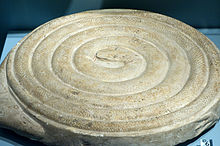
- Tabletop games
- Board games
- Tile-based games
- Turn-based games.html
- Abstract strategy games
- card games
- Connection games
- Mancala games
- Paper-and-pencil games
- Word games



 One example of Mehen.
One example of Mehen.Mehen is a board game that was played in ancient Egypt. The game was named in reference to Mehen, a mythological snake-god.
Evidence of the game of Mehen is found dating from approximately 3000 BC and continues until 2300 BC. Some of the best evidence appears during the Old Kingdom, in a picture in the tomb of Hesy-Ra. It is depicted in tombs of about 700 BC, but the board seems to have been misinterpreted as a vase, presumably because an Old Kingdom relief was copied by someone not familiar with the game itself.
It is known that the board depicts a game rather than being a religious object due to studies of paintings in tombs, and game boards and equipment found. None of the associated objects fit neatly within the segments of the snake. The rules and methods of play are completely unknown.
The board depicts a coiled snake whose body is divided into rectangular spaces. Several boards have been found with different numbers of segments, without distinguishing marks or ornamentation. The variability suggests that the number of segments was of little importance to the game. Objects associated with the board may or may not be playing pieces. From archaeological evidence, the game seemed to have been played with lion- or lioness-shaped game pieces, in sets of 3 or as many as 6, and a few small spheres (marbles/balls).